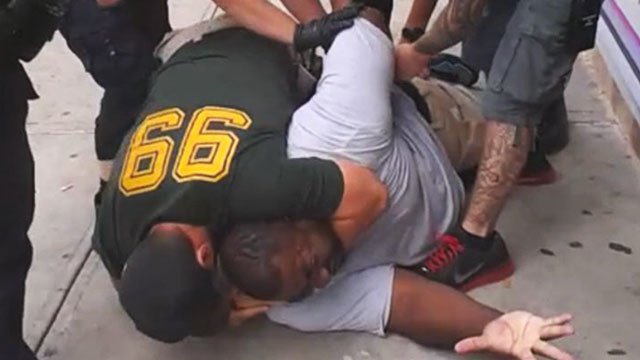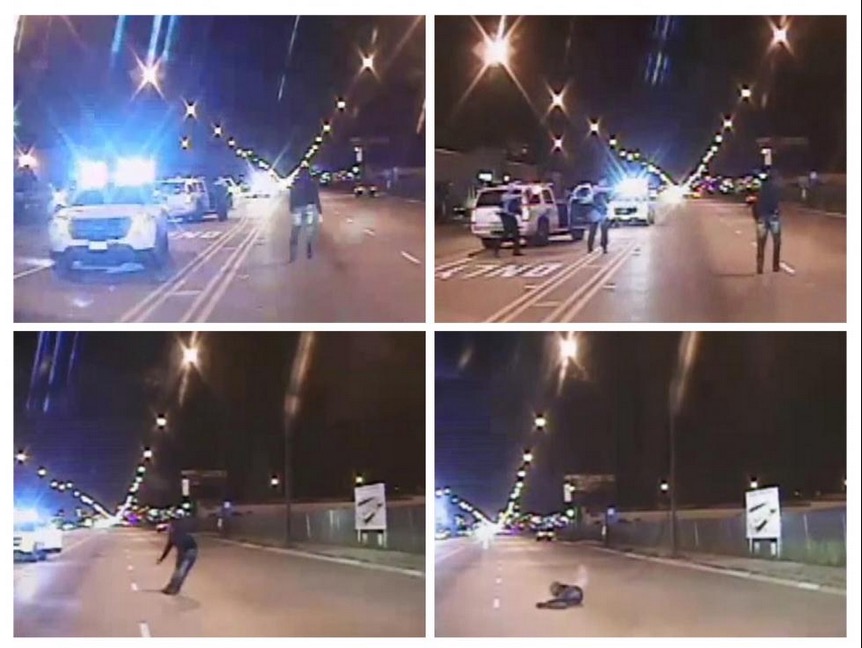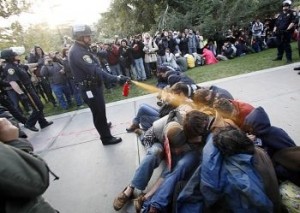
Cellphone video screenshot (YouTube), Eric Garner chokehold by NYPD officer Daniel Pantaleo, 7-15-14
I have commented periodically at this blog about citizen-journalist videos of grievous police misconduct. But the shameful spectacle of the nation’s top law officer, FBI Director James Comey, announcing repeatedly that the problem isn’t widespread and racially skewed abusive police behavior but citizen-journalist and police dashcam/bodycam videos of same, moved those issues front and center. Comey has the gall to claim, over and over again, that the nation is undergoing a “spike” in crime as a result of police reluctance to do their jobs — a hesitancy caused by concern that recording of their actions (especially recording that, unlike their dashcams and bodycams, the police can’t control) may get them in trouble … the so-called “Ferguson effect.”
Comey’s disgraceful commentary seeks simultaneously to blame the victim and kill the messenger, making it painfully obvious that the corruption of the nation’s justice system qualifies as systemic, not scattershot or anomalous, and runs all the way to the very top of that system’s chain of command. Coming as they did just a month before a Chicago judge forced that city’s mendacious mayor, the notorious weasel Rahm Emanuel, to release the horrific dashcam video of the police execution of Laquan McDonald, Comey’s grotesque claims highlighted the lengths to which the system will go to protect itself and avoid accepting any responsibility for its actions.
In response, since the situation depends so heavily on lens-based imagery in both its citizen journalism and citizen op-ed aspects, I have decided to offer, in installments, a thematically organized collection of the videos that provide evidence of pervasive police misconduct across the United States. Links to pertinent posts in this blog, which in turn contain links to relevant primary documents, news stories, still and video images, and other information, can be found here, the most recent first:
• Film the Police, 4 (8/15/16). In which I consider the “Investigation Report” on the Baltimore Department of Police issued by the U.S. Department of Justice. With a sidebar on the relationship between tragedy, pathos, and farce.
• Film the Police, 3 (1/27/16). In which I publish an open letter to FBI Director James Comey, calling on him to resign in the wake of his disgraceful comments about citizen journalism.
• Dog Day Afternoons: Bits & Pieces, 7 (8/27/15). In which I discuss “Structural Racism in Visual Form,” as manifested in media coverage of murders of black men by police officers.
• Spring Fever 2015: Bits & Pieces (5/3/15). In which I consider the case of Freddie Gray in Baltimore, and point toward advisories on the legal protections for those who film the police.
• Film the Police, 2 (1/21/15). In which I conclude an extended consideration of the killing of Eric Garner by a gang of police, just a few blocks from my home on Staten Island.
• Film the Police, 1 (1/18/15). In which I begin an extended consideration of the killing of Eric Garner by a gang of police, just a few blocks from my home on Staten Island.
•
This series actually had its inception back in 2011, when, on November 18, 2011, Lt. John Pike of the campus police force at the University of California-Davis doused a group of seated Occupy protestors with military-grade pepper spray at point-blank range. I began analyzing and commenting on the still and video imagery that emerged from that crisis in the 2011-2013 series Pepper-Spray Cop: Birth of a Meme, which you can think of as a narrowcast prelude to this later project. Many of my current thoughts on the issues involved had their formulations therein.
•
Special offer: If you want me to either continue pursuing a particular subject or write on a topic other than the current main story, make a donation of $50 via the PayPal widget below, indicating your preference in a note accompanying your donation. I’ll credit you as that new post’s sponsor, and link to a website of your choosing. Include a note with your snail-mail address (or email it to me separately) for a free signed copy of my 1995 book Critical Focus!








